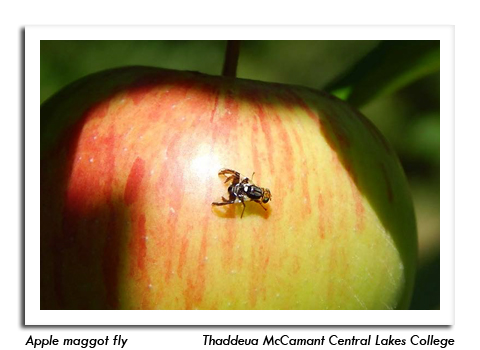
 |
|
|
Fruits
Volume 62 Number 13 Date 07/27/2017 APPLE MAGGOT - Captures of flies on red spheres and yellow sticky traps increased slightly in the past week, with counts ranging from 1-13 per trap. Approximately half of the apple maggot population should emerge between July 26 and August 6 across the southern two-thirds of the state, and from August 11-21 north of Wausau. Oviposition is expected to intensify for another 2-3 weeks. STINK BUG - Surveys in field crops suggest that activity is escalating and stink bugs are likely to start invading orchards in greater numbers. Growers can begin inspecting fruits in the week ahead for dimples or dark, irregular circular depressions typical of stink bug feeding, and should flag sites with multiple depressions on the same fruit or tree. Damage is often limited to specific areas in the orchard and depending on the distribution of the population, spot treatment may be adequate. WHITE APPLE LEAFHOPPER - Second-generation eggs are beginning to hatch. Apple growers who observed damage caused by the first generation several weeks ago should scout for stippling and whitish spots on leaves in the interior of tree canopies. The summer nymphs feed well into September and can cause significant chlorophyll loss. Ordinarily, control should target first generation nymphs, but if justified, treatments for the second generation are also effective. CODLING MOTH - The second flight is well underway. Regular trap checks should continue in August to determine if the economic threshold of five moths per trap per week is exceeded. The need for treatment of the second larval generation is less consistent than with the first generation, and depends upon the success of spring CM controls and whether pressure is coming from wild trees outside the orchard. Spot treatment is usually an effective approach for managing second-generation larvae. The high count for the last reporting period was 20 moths in Racine County, where a significant flight was recorded overnight on July 19. -- Krista Hamilton, DATCP Entomologist SPOTTED WING DROSOPHILA - Counts exceeded 100 or more flies per trap in eight of 18 traps during the week ending July 26. Three monitoring sites in La Crosse and Trempealeau counties reported 200 or more flies, with a weekly high capture of 425 flies. These elevated catch rates are consistent with the typical mid-July increase in SWD counts observed in the past 2-3 years, and indicate that berry growers should be prepared to manage SWD on farms with a combination of spray programs, as well as timely and clean harvests. Spray programs include maintaining a five-day spray interval, rotating at least three insecticides from different classes, such as Delegate/Entrust (spinosyn, bacterial based), Mustang Maxx (pyrethroid) and malathion (organophosphate). According to the MN Extension IPM Program, these products have shown the most consistent efficacy against SWD, and have pre-harvest intervals of one day that allows flexibility in scheduling harvest dates between sprays. The MN Extension also notes that two years of data have shown exclusion netting to be the best long-term solution for managing SWD in fall raspberries with minimal insecticide use. However, there are currently few suppliers and the initial capital investment is high. -- Information from Bill Hutchison, Eric Dominique Ebbenga, Adam Toninato and Suzanne Wold-Burkness, MN Extension IPM Program UMN http://www.mda.state.mn.us/plants/pestmanagement/ipm/ipmpubs/~/media/Files/plants/ipm/ipmupdate20170711.pdf JAPANESE BEETLE - Apple orchards in southern and western Wisconsin are reporting heavy beetle populations, with significant damage to foliage and the terminal ends of branches along orchard perimeters. If the beetles are causing unacceptable injury and treatment is required, growers can minimize insecticide use by spot treating only the most infested varieties. Insecticide options for this pest are limited. Growers who prefer a reduced-risk approach can apply a neonicotinoid at the first sign of feeding injury and before large aggregations appear. Neonicotinoids, e.g., Assail (acetamiprid), Actara (thiamethoxam), will offer good repellency and mortality within a few days. Additionally, imidacloprid products, e.g., Admire Pro, Alias, Wrangler, applied for apple maggot have anti-feeding properties and should also offer some Japanese beetle repellency. Where large aggregations have already formed and pressure is severe, a combination of a broad-spectrum insecticide, e.g., 1 ? 2 lb. of Imidan (phosmet) tank mixed with a neonicotinoid may give much better management of this pest. Carbamates and pyrethroids are also effective but are much more disruptive to biological controls and other natural enemies that may be active in the orchard. Never spray when bees are foraging. Organic producers have the option of applying PyGanic (pyrethrins) or neem (azadirachtin) oil products, e.g., Azadirect, Neemix, Trilogy. It is important to be aware that a botanical insecticide such as neem may be phytotoxic if tank mixed with other pesticides. If these treatments are required late in the season, be aware of pre-harvest intervals that vary between products. --Control recommendations provided IPM Institute of North America, Inc. 





|
|
|